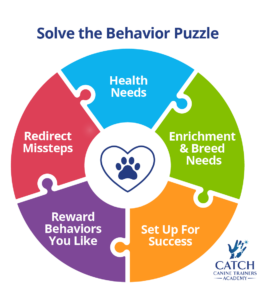There are many frameworks in the dog world that are designed to give us a sound approach to behavior change without relying on pain or fear. Here are a few great examples you may have heard of: LIMA, the Humane Hierarchy, LIFE, or the Hierarchy of Dog Needs. At CATCH, our goal is to take complex topics and make them easy to understand. So we’ve taken the core themes from these models and boiled it down to one clear, actionable method that we call Solve the Behavior Puzzle. This five-piece graphic provides a guide in how to make behavior change with compassion, respect, and a proven scientific approach. 
Start with Health Needs. Rule out pain or illness first. Even minor discomfort can drive major behavior issues. Hormonal imbalances like diabetes or hypothyroidism can impact mood, energy, and behavior. A dog that suddenly becomes irritable, reactive, or lethargic may be in pain or dealing with an undiagnosed medical condition. Trainers should look for signs like a runny nose, appetite loss, or unusual fatigue and suggest a vet visit when needed. It’s okay to excuse a dog from training if they’re not feeling well. Good behavior change starts with good health.
Enrichment & Breed Needs. Dogs are sentient, intelligent beings who think, feel, and form relationships. Their behaviors are expressions of emotion, instinct, and personality. They need to sniff, explore, run, and play in ways that satisfy them. Breed-specific tendencies like digging, herding, or barking aren’t problems to fix – they’re natural drives to support. A herding dog nipping at kids needs redirection to wrestle with a large stuffed toy or a game of Treibball. A terrier digging up the garden may thrive with a sandbox and hidden treasures. From Vizslas pointing at walls (because, surprise, there were rats!) to Ridgebacks tracking wildlife, honoring genetics with the right outlets solves more problems than a punishing correction will. These aren’t “bad” behaviors needing to be “fixed,” they’re normal behaviors that need a bit of intervention and guidance to fit into our complicated society.
Enrichment goes beyond toys and simple walks. It means mental puzzles, scent work, physical activity, and social experiences tailored to the individual.
Golden Retrievers may carry items during walks, while French Bulldogs thrive with playful tug games and sniffy strolls.
Enrichment must be dynamic and driven by understanding the individual dog and giving them choices. That means switching up textures, environments, and problem-solving opportunities, ensuring the dog gets to pick how they interact.
Set Up for Success. Use smart management to prevent unwanted behaviors. This might mean baby gates, tethers, or white noise to help a dog stay safe and relaxed. If a dog tends to bolt through doors, keep them leashed or install a doorway safety gate. If dogs in a multi-dog home argue over food, keep high value chews for crate times or feed them in separate rooms. Predict the problem and block it before it happens. This prevents the behavior from getting practiced and reinforced. It protects your relationship with the dog, as opposed to punishment which can damage the relationship. Management also reduces stress. Stress usually makes problems worse while no-stress keeps dogs open to learning and ready for training.
Reward Behaviors You Like. Dogs learn through repetition and emotion. That learning happens both in everyday moments and in intentional, step-by-step training. When something feels good and earns attention or treats (deliberate or not), they’re likely to do it again.
Real-Life Moments: Catch Good Choices as They Happen
If your dog jumps up when greeting people, teach them to sit or hand target as a new way to say hello. Reward it like it’s the best thing they’ve ever done.
If they bark for attention, guide them to bring a toy or rest quietly by your feet, and reinforce that instead.
These aren’t just tricks. They are life skills that help dogs understand us and build lasting two-way communication and trust. This kind of in-the-moment feedback helps dogs make good choices again and again. You don’t need perfect timing or fancy cues. Just catch the moments you like: the calm sit, the toy delivered instead of a bark, the glance toward you before a distraction,and make those moments matter with praise, treats, or play. You will see them repeated because they “pay off” for the dog.
Training Plans: Build Skills One Step at a Time
Beyond real-life reinforcement, it’s essential to teach behaviors with thoughtful, step-by-step training. This means introducing a new skill in a quiet space, helping your dog succeed, and gradually increasing difficulty. Sit becomes stay. A glance becomes focus. Coming when called turns into a reliable recall, even around squirrels.
A good training plan is like building a ladder: one rung at a time, with support and celebration at every step.
Think of it like giving your dog a roadmap. You’re not just hoping they stumble onto the right path. You’re walking it with them. You’re clearly marking the way and celebrating every correct turn. Over time, your dog learns to make better choices because they’ve experienced the joy of getting it right through repeated success, and they’ve practiced how to get there.
Redirect Missteps. When mistakes happen (and they will), guide your dog to a better option. Use a light noise or verbal cue to interrupt, then guide them to an alternate behavior you can reward. If they grab a sock, trade for a tug toy. If they start barking at the window, call them over for a treat. This is a powerful form of teaching that works right there in real life. Everything doesn’t have to be taught in formal training sessions. Redirection protects your bond while gently and clearly steering behavior in the right direction.
Solving the Behavior Puzzle is a framework designed to give clarity and confidence. It helps all of us teach with purpose and kindness. It also helps dogs feel seen, supported, and safe. This makes a big difference in successful behavior change!
https://catchdogtrainers.com/lets-simplify-behavior-change-solve-the-behavior-puzzle-2025-05-16/
